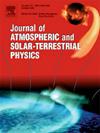Spectral observation of the 24 solar terms on the Qinghai–Tibet Plateau: A case study of Lhasa, Tibet
IF 1.9
4区 地球科学
Q3 GEOCHEMISTRY & GEOPHYSICS
Journal of Atmospheric and Solar-Terrestrial Physics
Pub Date : 2025-05-16
DOI:10.1016/j.jastp.2025.106543
引用次数: 0
Abstract
Twenty-four solar terms, which were created by farmers in ancient China, are based on the Earth's orbit around the Sun and reflect the changes in climate, natural phenomena, agricultural production and other aspects of human life. In this study, we conducted observations and analysed the solar spectrum of the 24 solar terms in Lhasa, Qinghai–Tibet Plateau using a high-precision solar irradiance metre. The objective was to investigate the relationship between solar radiation variations and geophysical processes in the Qinghai–Tibet Plateau region. The results showed that during the period from the Autumnal Equinox on September 23, 2022 to the Qingming Festival on April 5, 2023, the lowest environmental humidity was only 4.7 %. The impact of the atmospheric water vapor and clouds on solar radiation was relatively small, and the solar spectrum exhibited good regularity. However, during the remaining solar terms, the solar spectrum exhibited fluctuations caused by temperature, humidity and other factors. Among the 24 solar terms in Lhasa during the Summer Solstice in 2022 and 2023, the peak values of monochromatic light were 2.53 W m−2·nm−1 and 2.71 W m−2·nm−1, respectively, considering the combined effects of sunlight reflection and scattering caused by discrete clouds. These values exceed the peak value of the AM0 monochromatic light. By comparing the Fraunhofer lines during the ‘Two Equinoxes and Two Solstices’ in Lhasa, the absorption peaks of the Fe, Ca, H, Mg, Na and O elements were observed at wavelengths of 358 nm, 431 nm, 486 nm, 517 nm, 589 nm and 687 nm, respectively. These results provide a foundation for further investigation of solar radiation variations on the Qinghai–Tibet Plateau and their impact on the Earth and can be used as a reference for sustainable research in the Qinghai–Tibet Plateau region of China.
青藏高原24节气的光谱观测——以西藏拉萨为例
二十四节气是中国古代农民根据地球围绕太阳的轨道创造的,反映了气候、自然现象、农业生产和人类生活其他方面的变化。本文利用高精度太阳辐照度计对青藏高原拉萨地区24节气的太阳光谱进行了观测和分析。目的是研究青藏高原地区太阳辐射变化与地球物理过程的关系。结果表明,2022年9月23日秋分至2023年4月5日清明期间,最低环境湿度仅为4.7%。大气水汽和云层对太阳辐射的影响相对较小,太阳光谱具有较好的规律性。然而,在其余节气中,太阳光谱受到温度、湿度等因素的波动。2022年和2023年拉萨地区24节气中,考虑到离散云对阳光反射和散射的综合影响,单色光峰值分别为2.53 W m−2·nm−1和2.71 W m−2·nm−1。这些值超过了AM0单色光的峰值。通过对比拉萨“两分两至”期间的弗劳恩霍夫谱线,分别在358nm、431nm、486nm、517nm、589nm和687nm波长处观察到Fe、Ca、H、Mg、Na和O元素的吸收峰。这些结果为进一步研究青藏高原太阳辐射变化及其对地球的影响奠定了基础,可为青藏高原地区的可持续研究提供参考。
本文章由计算机程序翻译,如有差异,请以英文原文为准。
求助全文
约1分钟内获得全文
求助全文
来源期刊

Journal of Atmospheric and Solar-Terrestrial Physics
地学-地球化学与地球物理
CiteScore
4.10
自引率
5.30%
发文量
95
审稿时长
6 months
期刊介绍:
The Journal of Atmospheric and Solar-Terrestrial Physics (JASTP) is an international journal concerned with the inter-disciplinary science of the Earth''s atmospheric and space environment, especially the highly varied and highly variable physical phenomena that occur in this natural laboratory and the processes that couple them.
The journal covers the physical processes operating in the troposphere, stratosphere, mesosphere, thermosphere, ionosphere, magnetosphere, the Sun, interplanetary medium, and heliosphere. Phenomena occurring in other "spheres", solar influences on climate, and supporting laboratory measurements are also considered. The journal deals especially with the coupling between the different regions.
Solar flares, coronal mass ejections, and other energetic events on the Sun create interesting and important perturbations in the near-Earth space environment. The physics of such "space weather" is central to the Journal of Atmospheric and Solar-Terrestrial Physics and the journal welcomes papers that lead in the direction of a predictive understanding of the coupled system. Regarding the upper atmosphere, the subjects of aeronomy, geomagnetism and geoelectricity, auroral phenomena, radio wave propagation, and plasma instabilities, are examples within the broad field of solar-terrestrial physics which emphasise the energy exchange between the solar wind, the magnetospheric and ionospheric plasmas, and the neutral gas. In the lower atmosphere, topics covered range from mesoscale to global scale dynamics, to atmospheric electricity, lightning and its effects, and to anthropogenic changes.
 求助内容:
求助内容: 应助结果提醒方式:
应助结果提醒方式:


